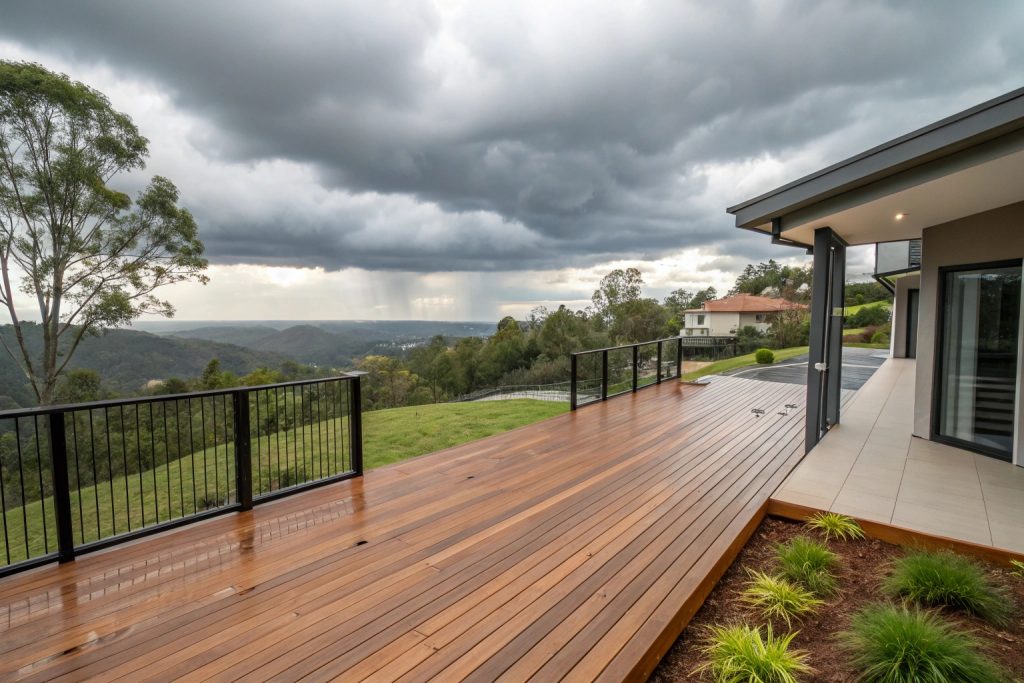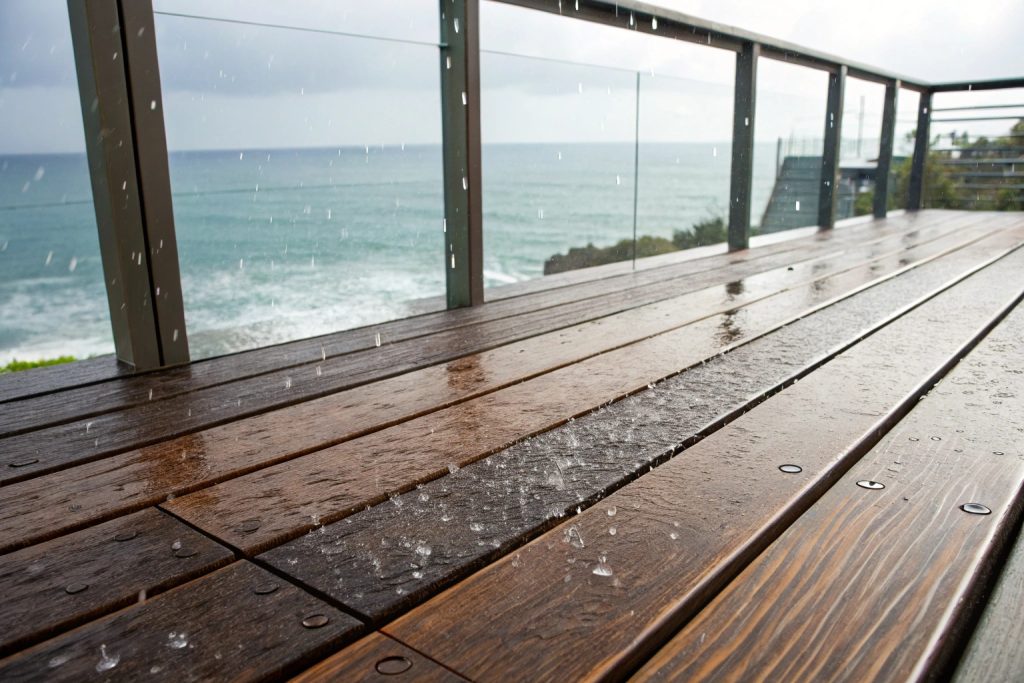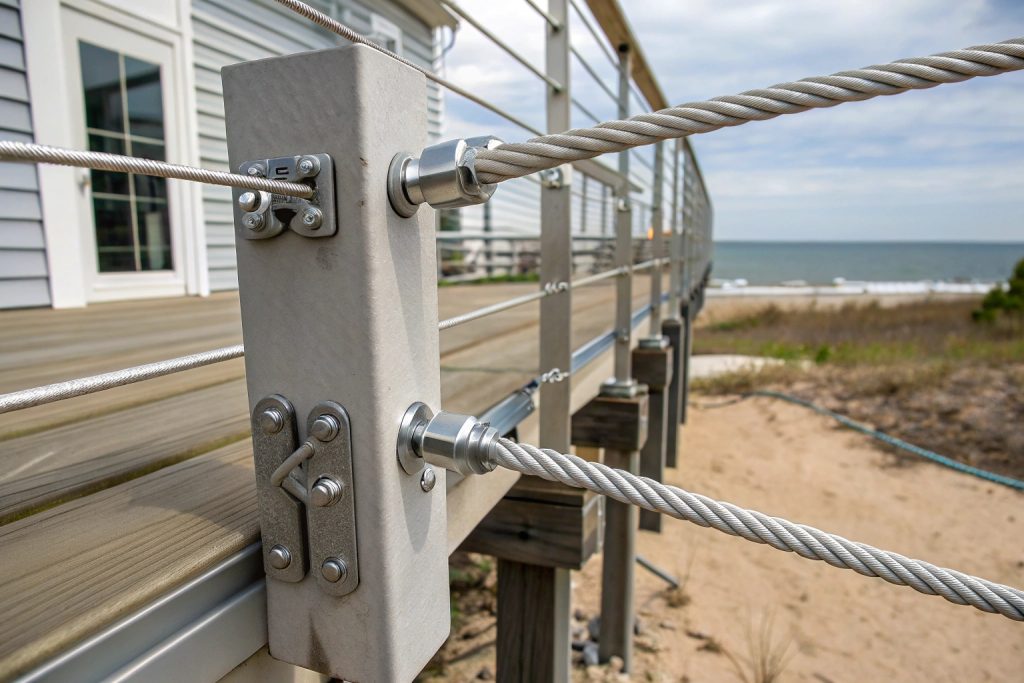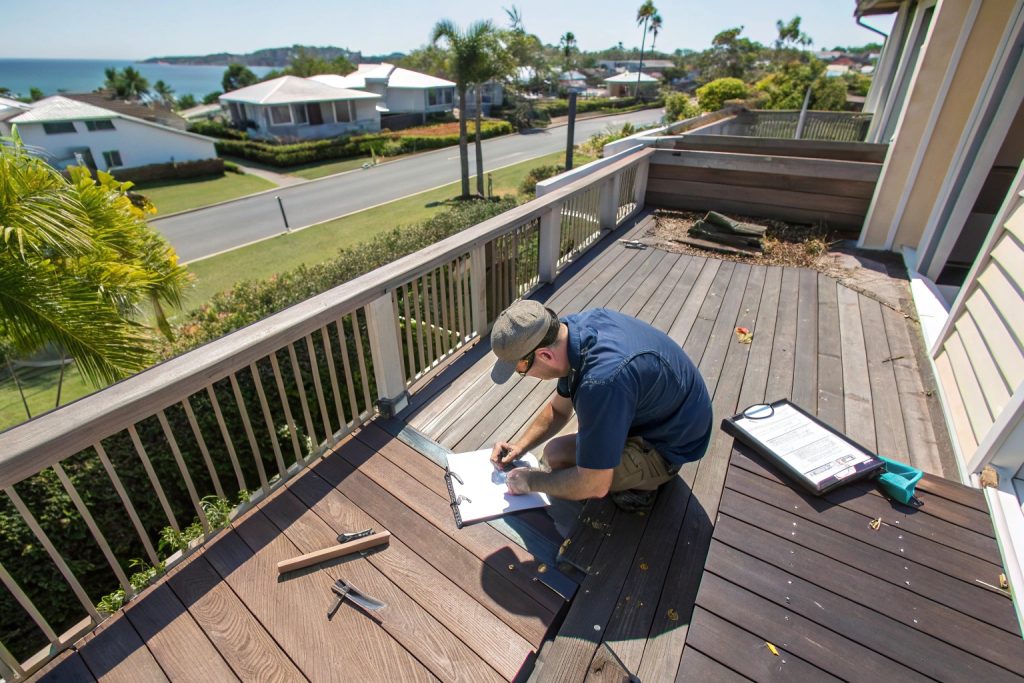Choosing between a multi-level and single-level deck is one of the biggest decisions homeowners face…
Storm-Proof Decking Gold Coast: Protecting Your Investment Year-Round
Living in Burleigh Heads or anywhere along our gorgeous Gold Coast means enjoying an outdoor lifestyle almost year-round. But let’s be honest – our slice of paradise comes with its fair share of weather challenges. Those summer storms can hit hard and fast, leaving unprepared deck owners with expensive repairs and headaches.
Building a deck that can handle our unique Gold Coast weather isn’t just about choosing nice timber and hoping for the best. It’s about understanding how our local conditions affect outdoor structures and building specifically to address those challenges. For families investing $15,000+ in their outdoor living space, cutting corners on storm-proofing is a mistake that’ll cost you down the track.
Whether you’re planning a new build or wanting to strengthen your existing deck, these strategies will help protect your investment for years to come.
How Summer Storms Impact Outdoor Structures in Burleigh Heads
Our Gold Coast summers bring those classic afternoon thunderstorms that can dump massive amounts of rain in just minutes. For Burleigh Heads properties, this creates unique challenges you might not face in other parts of Australia.
The combination of intense UV exposure weakening materials and torrential downpours puts enormous stress on outdoor structures. Your deck cops a double whammy – expanding in the heat, then quickly contracting when cooled by sudden rain. This constant expansion and contraction cycle eventually leads to warping, splitting, and loosening of fixings.

But it’s not just the rain itself. The geography around Burleigh, with its hills and slopes, means water runoff becomes a major issue. Water that can’t drain properly sits against your deck, causing premature rot and creating perfect conditions for mould growth.
Those famous Gold Coast wind gusts create another problem. They drive rain horizontally, pushing water into joins and underneath your decking boards. This trapped moisture is our region’s number one killer of decks, often causing damage you won’t notice until it’s too late.
Salt exposure is another factor we can’t ignore. Even if you’re a few streets back from the beach, that salt air permeates everything and accelerates corrosion of metal fasteners and fittings. I’ve seen stainless steel screws completely rust through in under two years in homes close to the shoreline.
The truth is, a deck built to standard specifications for Sydney or Melbourne simply won’t withstand our unique climate conditions. You need solutions specifically designed for Gold Coast weather patterns.
Critical Engineering Elements for Storm-Resistant Decks
When I design storm-proof decking for Gold Coast homes, several non-negotiable engineering elements determine the difference between a deck that lasts 5 years and one that lasts 25+ years.
First up, your subframe structure needs to be rock solid. I always recommend using H4-treated pine at a minimum for the structural components, with posts properly anchored using concrete footings extending below the frost line. For areas within 500m of the ocean, we use stainless steel brackets rather than standard galvanised ones, which simply can’t handle the salt exposure.
Joist spacing is critical, too. While standard recommendations might suggest 450mm centres, for storm-proof decking in Gold Coast conditions, we tighten this to 400mm or even 350mm for added resilience against our heavy rain events. This closer spacing provides additional support when timber is most vulnerable – when it’s saturated with moisture.
Your decking boards themselves need special attention. Standard decking often has flat-bottomed grooves, which trap water. Instead, we use boards with V-grooved undersides that allow water to drain and air to circulate. This small design change dramatically reduces rot potential.
The direction of your decking boards matters too. We always install them perpendicular to your house, never parallel. This creates natural channels for water to flow away from your home’s foundation during heavy rain.
Fixings are another area where quality makes a huge difference. I’ve replaced too many decks where builders used cheap screws that failed within 18 months. We exclusively use high-grade stainless steel screws with proper rust resistance ratings. Yes, they cost about 30% more, but they’ll outlast standard screws by 5-10 times in our coastal environment.
Water Drainage Solutions for Hillside Properties
The biggest mistake I see on hillside decks is inadequate planning for water flow paths. During a typical Gold Coast summer storm, water cascades down these slopes with surprising force. Your deck must be designed not to fight this water, but to channel it safely away.
For decks built on hills, we always incorporate a slight gradient, typically 1-2 degrees, sloping away from the house. This gentle fall is barely noticeable when you’re standing on the deck, but it makes an enormous difference during heavy rain, allowing water to sheet off rather than pool.
Beneath the deck, installing a water diversion system is essential. We use special geotextile fabric under our hillside decks, installed at a gradient that directs water toward designated drainage points. This fabric allows water to flow while preventing soil erosion underneath your deck – another common failure point.

For seriously steep blocks, we often install french drains along the uphill side of the deck. These gravel-filled trenches with perforated pipes capture and redirect water before it ever reaches the deck structure. One Paradise Point client had suffered three separate deck failures until we installed this system – they haven’t had a single issue through five storm seasons since.
The space between your decking boards becomes even more important on hillside properties. While standard practice might use 4-5mm spacing, for storm-proof decking on Gold Coast hillside properties, we increase this to 6-8mm. This wider gap allows for better drainage and air circulation, which is crucial when you’re dealing with intense water flow.
Ground level decks on slopes need special attention too. We always install a layer of crushed rock beneath them rather than letting them sit directly on soil. This creates a drainage zone that prevents water from wicking up into your timber from below.
Wind Rating: What Burleigh Homeowners Need to Know
Most decks in Burleigh Heads should be built to handle at least W41 wind classification (that’s wind speeds up to 50m/second). But here’s what many homeowners don’t realise: your property might need an even higher rating depending on your exact location, elevation, and surrounding landscape.
The fixings connecting your deck to your home are particularly vulnerable during high winds. We use cyclone ties and heavy-duty brackets with multiple fixing points to create a super-strong connection between your deck and house. For freestanding decks, we drive posts significantly deeper than standard recommendations – typically 900mm minimum rather than the standard 600mm.
Pergolas and roofed deck areas need extra attention for wind resistance. The uplift force during a storm can literally tear a roof off if it’s not properly secured. We use specialised cyclone rods that run from the footings all the way through to the roof structure, creating one continuous anchored system.

Railings and balustrades act like sails in high winds. We’ve switched to using systems with partial openings that allow some wind to pass through, reducing the overall wind load. For glass balustrades, which are popular for their unobstructed views, we only use panels rated for cyclonic conditions, which are significantly thicker than standard options.
Corner sections of your deck experience the highest wind pressures – up to 2.5 times what the middle sections experience. We reinforce these corners with additional structural members and fixings. This targeted strengthening at high-stress points provides massive benefits without adding unnecessary cost to the entire project.
One often-overlooked wind consideration is furniture anchoring. We can install discrete stainless steel anchor points flush with your decking, allowing you to secure outdoor furniture during storm warnings. Several clients have told me these simple additions saved their expensive outdoor settings from becoming dangerous projectiles during last year’s big storms.
Maintenance Schedule to Prepare Your Deck for Storm Season
Having a storm-proof decking on the Gold Coast isn’t just about how it’s built – it’s also about how you maintain it through our challenging seasons. A proper maintenance schedule can dramatically extend the life of your deck and enhance its resistance to storm damage.

- Before storm season hits (typically October), check all your deck fixings. Look for any screws or bolts that have worked loose over time. This simple check takes about 20 minutes but can prevent major structural failures when those summer storms roll in. Pay special attention to areas connecting to your house, as these critical joints often experience the most movement.
- Clean between your decking boards at least quarterly. Those small gaps between boards are designed for drainage, but they quickly fill with leaves and debris. When blocked, water pools on your deck surface rather than draining away. A pressure washer on a low setting works well, or you can use a specialised deck cleaning tool with bristles designed to clean these channels.
- Apply a quality water-repellent sealer annually. For storm-proof decking on the Gold Coast, timing this application is crucial. We recommend doing it in early spring, giving it time to fully cure before storm season. Don’t be tempted by cheap sealers – they break down quickly in our harsh UV conditions. A quality product might cost $180-220 for an average deck, but offers significantly better protection.
- Check your drainage systems before big rains. If you have gutters, drainage channels, or water diversion systems around your deck, make sure they’re clear and functioning. After every major storm, do a quick inspection for any debris that might block drainage paths.
- Trim overhanging trees and vegetation away from your deck before storm season. During high winds, branches can cause significant damage to your deck surface and railings. Plus, leaf litter from nearby trees will constantly clog your drainage channels during storms.
If you’ve got a particularly valuable outdoor living space, consider having a professional deck inspection annually. We offer a pre-storm season check that costs about $250, but can identify hidden issues before they become major problems. Many of our clients build this into their regular maintenance schedule, treating it like a health check-up for their deck.
